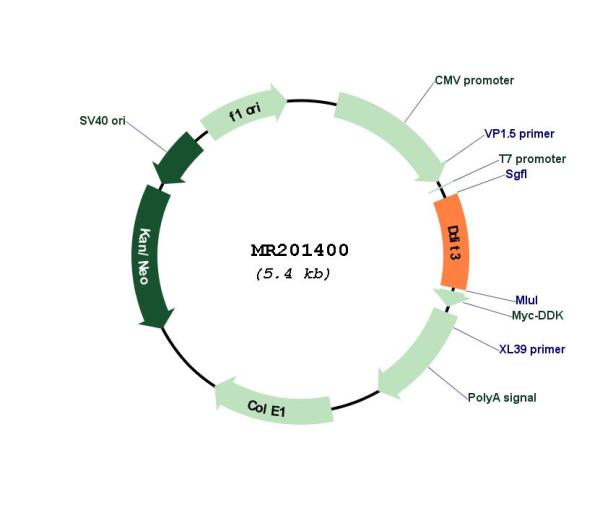Ddit3 (NM_007837) Mouse Tagged ORF Clone
CAT#: MR201400
- TrueORF®
Ddit3 (Myc-DDK-tagged) - Mouse DNA-damage inducible transcript 3 (Ddit3)
ORF Plasmid: tGFP
Lentiviral Particles: DDK w/ Puro mGFP w/ Puro
"NM_007837" in other vectors (4)
Interest in protein/lysate? Submit request here!
USD 198.00
Specifications
| Product Data | |
| Type | Mouse Tagged ORF Clone |
| Tag | Myc-DDK |
| Symbol | Ddit3 |
| Synonyms | chop; CHOP-10; CHOP10; gadd153 |
| Vector | pCMV6-Entry |
| E. coli Selection | Kanamycin (25 ug/mL) |
| Mammalian Cell Selection | Neomycin |
| Sequence Data |
>MR201400 ORF sequence
Red=Cloning site Blue=ORF Green=Tags(s) TTTTGTAATACGACTCACTATAGGGCGGCCGGGAATTCGTCGACTGGATCCGGTACCGAGGAGATCTGCC GCCGCGATCGCC ATGGCAGCTGAGTCCCTGCCTTTCACCTTGGAGACGGTGTCCAGCTGGGAGCTGGAAGCCTGGTATGAGG ATCTGCAGGAGGTCCTGTCCTCAGATGAAAATGGGGGCACCTATATCTCATCCCCAGGAAACGAAGAGGA AGAATCAAAAACCTTCACTACTCTTGACCCTGCGTCCCTAGCTTGGCTGACAGAGGAGCCAGGGCCAACA GAGGTCACACGCACATCCCAAAGCCCTCGCTCTCCAGATTCCAGTCAGAGTTCTATGGCCCAGGAGGAAG AGGAGGAAGAGCAAGGAAGAACTAGGAAACGGAAACAGAGTGGTCAGTGCCCAGCCCGGCCTGGGAAGCA ACGCATGAAGGAGAAGGAGCAGGAGAACGAGCGGAAAGTGGCACAGCTAGCTGAAGAGAACGAGCGGCTC AAGCAGGAAATCGAGCGCCTGACCAGGGAGGTGGAGACCACACGGCGGGCTCTGATCGACCGCATGGTCA GCCTGCACCAAGCA ACGCGTACGCGGCCGCTCGAGCAGAAACTCATCTCAGAAGAGGATCTGGCAGCAAATGATATCCTGGATT ACAAGGATGACGACGATAAGGTTTAA >MR201400 protein sequence
Red=Cloning site Green=Tags(s) MAAESLPFTLETVSSWELEAWYEDLQEVLSSDENGGTYISSPGNEEEESKTFTTLDPASLAWLTEEPGPT EVTRTSQSPRSPDSSQSSMAQEEEEEEQGRTRKRKQSGQCPARPGKQRMKEKEQENERKVAQLAEENERL KQEIERLTREVETTRRALIDRMVSLHQA TRTRPLEQKLISEEDLAANDILDYKDDDDKV |
| Restriction Sites |
SgfI-MluI
Cloning Scheme for this gene
Plasmid Map

|
| ACCN | NM_007837 |
| ORF Size | 507 bp |
| OTI Disclaimer | Due to the inherent nature of this plasmid, standard methods to replicate additional amounts of DNA in E. coli are highly likely to result in mutations and/or rearrangements. Therefore, OriGene does not guarantee the capability to replicate this plasmid DNA. Additional amounts of DNA can be purchased from OriGene with batch-specific, full-sequence verification at a reduced cost. Please contact our customer care team at custsupport@origene.com or by calling 301.340.3188 option 3 for pricing and delivery. The molecular sequence of this clone aligns with the gene accession number as a point of reference only. However, individual transcript sequences of the same gene can differ through naturally occurring variations (e.g. polymorphisms), each with its own valid existence. This clone is substantially in agreement with the reference, but a complete review of all prevailing variants is recommended prior to use. More info |
| OTI Annotation | This clone was engineered to express the complete ORF with an expression tag. Expression varies depending on the nature of the gene. |
| Product Components | The ORF clone is ion-exchange column purified and shipped in a 2D barcoded Matrix tube containing 10ug of transfection-ready, dried plasmid DNA (reconstitute with 100 ul of water). |
| Reconstitution | 1. Centrifuge at 5,000xg for 5min. 2. Carefully open the tube and add 100ul of sterile water to dissolve the DNA. 3. Close the tube and incubate for 10 minutes at room temperature. 4. Briefly vortex the tube and then do a quick spin (less than 5000xg) to concentrate the liquid at the bottom. 5. Store the suspended plasmid at -20°C. The DNA is stable for at least one year from date of shipping when stored at -20°C. |
| Reference Data | |
| RefSeq | NM_007837.2, NP_031863.2 |
| RefSeq Size | 888 bp |
| RefSeq ORF | 507 bp |
| Locus ID | 13198 |
| UniProt ID | P35639 |
| Cytogenetics | 10 D3 |
| MW | 19.2 kDa |
| Gene Summary | Multifunctional transcription factor in ER stress response. Plays an essential role in the response to a wide variety of cell stresses and induces cell cycle arrest and apoptosis in response to ER stress. Plays a dual role both as an inhibitor of CCAAT/enhancer-binding protein (C/EBP) function and as an activator of other genes. Acts as a dominant-negative regulator of C/EBP-induced transcription: dimerizes with members of the C/EBP family, impairs their association with C/EBP binding sites in the promoter regions, and inhibits the expression of C/EBP regulated genes. Positively regulates the transcription of TRIB3, IL6, IL8, IL23, TNFRSF10B/DR5, PPP1R15A/GADD34, BBC3/PUMA, BCL2L11/BIM and ERO1L. Negatively regulates; expression of BCL2 and MYOD1, ATF4-dependent transcriptional activation of asparagine synthetase (ASNS), CEBPA-dependent transcriptional activation of hepcidin (HAMP) and CEBPB-mediated expression of peroxisome proliferator-activated receptor gamma (PPARG). Inhibits the canonical Wnt signaling pathway by binding to TCF7L2/TCF4, impairing its DNA-binding properties and repressing its transcriptional activity. Plays a regulatory role in the inflammatory response through the induction of caspase-11 (CASP4/CASP11) which induces the activation of caspase-1 (CASP1) and both these caspases increase the activation of pro-IL1B to mature IL1B which is involved in the inflammatory response. Acts as a major regulator of postnatal neovascularization through regulation of endothelial nitric oxide synthase (NOS3)-related signaling.[UniProtKB/Swiss-Prot Function] |
Documents
| Product Manuals |
| FAQs |
| SDS |
Resources
Other Versions
| SKU | Description | Size | Price |
|---|---|---|---|
| MC200990 | Ddit3 (untagged) - Mouse DNA-damage inducible transcript 3 (Ddit3), (10ug) |
USD 450.00 |
|
| MG201400 | Ddit3 (tGFP-tagged) - Mouse DNA-damage inducible transcript 3 (Ddit3) |
USD 650.00 |
|
| MR201400L3 | Lenti ORF clone of Ddit3 (Myc-DDK-tagged) - Mouse DNA-damage inducible transcript 3 (Ddit3) |
USD 750.00 |
|
| MR201400L4 | Lenti ORF clone of Ddit3 (mGFP-tagged) - Mouse DNA-damage inducible transcript 3 (Ddit3) |
USD 750.00 |
{0} Product Review(s)
Be the first one to submit a review






























































































































































































































































 Germany
Germany
 Japan
Japan
 United Kingdom
United Kingdom
 China
China


